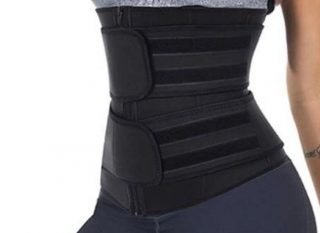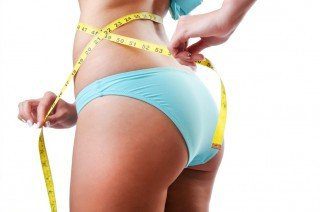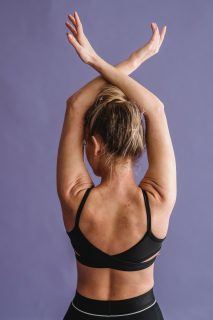Many women lust over the idea of a tiny waist and hourglass figure. Which explains why waist trainers have become so popular. Getting a waist trainer belt for lower belly fat is increasingly worn during work-outs, but are they safe to wear? Or should we be giving them the boot?
What is a waist trainer?
 Lets’ start with the basics, what even is a waist trainer? The waist trainer is in essence, the modern version of a corset. There are different variations and some are more vicious than others. Like corsets, they are meant to be worn under clothing and often contain metal boning. They are worn around the midsection and usually make use of a lacing system, velcro or hooks to close them. Was it trainers are usually made of thick, elastic material and should be tighter than a girdle or shapewear.
Lets’ start with the basics, what even is a waist trainer? The waist trainer is in essence, the modern version of a corset. There are different variations and some are more vicious than others. Like corsets, they are meant to be worn under clothing and often contain metal boning. They are worn around the midsection and usually make use of a lacing system, velcro or hooks to close them. Was it trainers are usually made of thick, elastic material and should be tighter than a girdle or shapewear.
What are some of the supposed benefits associated
The keyword here is supposed. Many of the claims come directly from the companies that make waist trainers. Thus, it’s best to take all these claims of so-called benefits with a pinch of salt. The two main claims are an hourglass figure and weight loss as a direct result of wearing the waist trainer.
A small waist and hourglass figure
Theoretically, the idea is that a waist trainer will reduce fat pockets around the waist. Specifically, the fat pockets near the floating ribs. The floating ribs

Elnur/Shutterstock
are the two lowest ribs that aren’t attached to the breastbone. In theory, these two lowest ribs would be molded and manipulated into creating that much lusted after hourglass figure. However, the truth seems to be that this won’t work in the long term. In fact, according to the American Board of Cosmetic Surgery, wearing a waist trainer won’t cause any drastic change in the body and any perceived changes will be short-lived. Essentially, that tiny waist won’t stick around unless you are wearing your waist trainer regularly.
Weight loss
Though it might look like you are achieving weight loss more quickly, it’s actually not that simple. Waist trainers, due to the amount of compression and the material, make you perspire a lot more. The ‘weight loss’ you’re seeing is more as a result of water loss from excess sweat than it is down to actual fat loss. Okay, so you’re sweating more, this must be a good thing, right? Whilst it’s true that normally, sweating means that the body is working harder, in the case of waist training, this is not the truth. In fact, it seems that the excess compression might even have a negative effect on the muscles.
Okay, they may not work in the long term, but are they safe?
The answer here seems to be no. That is unless you are wearing it temporarily for a special occasion. Usually, it’s recommended that you wear your waist trainer for a solid 8 hours a day. This is not recommended by medical professionals and is, actually considered very risky. You also shouldn’t be wearing it while you sleep or while you exercise.
What are the side effects?
 Unfortunately for any of us who have splashed out on an expensive waist trainer, the risks here seem to outweigh any benefits.
Unfortunately for any of us who have splashed out on an expensive waist trainer, the risks here seem to outweigh any benefits.
They actually weaken abdominal muscles
One of the things most medical professionals agree on is that, in the long term, using a waist trainer will result in weaker abdominal muscles. When you wear a waist trainer, you are restricting the airflow into the muscles and simultaneously compressing them. Casey Palazzo, certified Lagree Instructor, at The Studio (MDR) explained to Byrdie that they can actually prevent the core muscles from being able to engage. This means that you’ll actually be losing strength and definition according to Palazzo. Waist trainers also offer support when it comes to standing up straight. This actually causes the muscles in the core to become reliant on it and these muscles deactivate as they sense they are not necessary.
Other negative impacts of waist training
There are definitely more negatives than positives when it comes to waist training.
Restrict airflow: They constrict the bottom ribs (the floating ribs) in order to give the illusion of an hourglass shape. This makes it difficult to breathe properly and can lead to a decrease in lung capacity which is especially important when exercising. They also inhibit the diaphragm and can also cause you to pass out when pulled too tight.
Pressure on internal organs: As with corsets of old, this is no doubt an issue. Your organs need to move in order to function properly. A waist trainer

Photo by Marta Wave from Pexels
compresses them and can put them under unnecessary stress. Unfortunately, there are no legitimate studies when it comes to waist training which makes it difficult to know what the long-term effects might be. However, according to Jesse P. Houghton, MD, senior medical director of Gastroenterology at Southern Ohio Medical Center, it would require very long-term sustained wear in order to permanently move the organs.
There are healthier ways to shape your waist
Admittedly, it is difficult to target any specific area with diet and exercise. However, according to Palazzo, there are specific exercises that can help to strengthen the core, carve out the waist and tighten the oblique muscles. She recommends exercises that target the obliques specifically as well as side bends. Ultimately, you shouldn’t be risking your health in order to get a smaller waist. It would be better (and much healthier) to alter your diet and exercise routine in order to try to target areas like the waist.
References
https://www.byrdie.com/waist-training-4783065
https://www.healthline.com/health/do-waist-trainers-work#what-is-it
https://www.americanboardcosmeticsurgery.org/popular-posts/4-reasons-throw-waist-trainer-trash/





![women [longevity live]](https://longevitylive.com/wp-content/uploads/2020/01/photo-of-women-walking-down-the-street-1116984-100x100.jpg)










